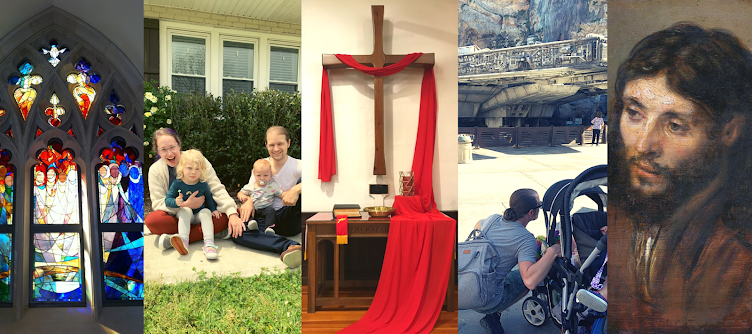The other day, I read (in one of Noah’s Christmas picture
books, of all places) a verse from “Hark! the Herald Angels Sing” that I don’t
think I’ve ever heard before. Like so many of Charles Wesley’s lyrics, it’s
dense with scriptural echoes and theological meaning:
.JPG) |
| Charles Wesley (1707-1788) |
Fix in us Thy humble home:
Rise, the woman’s conqu’ring seed,
Bruise in us the serpent’s head;
Adam’s likeness now efface,
Stamp Thine image in its place:
Final Adam from above,
Reinstate us in Thy love.
What is Wesley talking about? And what does it have to do
with the birth of Christ?
This verse opens with a phrase from Haggai 2:7, which speaks
of a day when “the desire of all nations will come.” The rest of the lines all
connect to the story of Adam and Eve in the book of Genesis and the way St.
Paul applies that story to our lives in his letters.
First, Wesley alludes to Genesis 3:15. Immediately after
discovering the deception that led humanity to sin, the Lord tells the serpent:
I will put enmity
between you and the woman,
and between your offspring and hers;
he will crush your head,
and you will strike his heel.
You can take that as a general statement about how much
people hate snakes, but this verse has often been read as a
reference to Jesus. He is the woman’s seed, her offspring, who will bruise the
serpent’s head “in us,” who will conquer the devil’s influence in our lives.
Because of that influence, we need “Adam’s likeness,” the
sin-wrecked inclinations and impulses that all humanity shares, to be ousted
from our lives and replaced by the likeness of Jesus. He is the perfect image
of God (Col 1:15), and he modeled for us what it would look like for human
beings to reflect that image in our lives—like we were originally created to do
(Gen 1:27). Jesus is the “Final Adam” (or, “last Adam,” 1 Cor 15:45) who
established an alternative way to be descendants of Adam, trailblazing a new,
holy path for humanity.
So, Mary’s baby boy came to stomp heads, to defeat the power
of the devil, creating a chance for us to be the people we were created to be, the
image of God. If we—to quote the United Methodist Church’s baptismal vows—accept
the freedom and power that God gives us to resist evil, injustice, and
oppression, then we can step out of the first Adam’s shadow, and begin new
lives reflecting the Final Adam. We can abide in his love (John 15:9-10).
Wesley crammed all of that into a verse of a Christmas carol
because he understood that Christmas, the Son of God becoming the Son of
Mary, human like us, is the linchpin of all of these incredible, gospel
promises of deliverance and new life. Jesus didn’t only come to die. He
came to break the mold and reshape humanity. It’s because God became a man that
we can hope to overcome sin. It’s because of the baby in the manger that we can
“walk in newness of life” (Rom 6:4).
Christmas means you can be free from sin’s power.
Christmas means your life can be different.
“Adam’s likeness now efface, Stamp Thine image in its
place."

2 comments:
Good morning Nance,
Thank you for this excellent explanation of this verse. It is so "deep" and you are so gifted in explaining difficult verses. God has truly blessed and anointed you with discernment, wisdom, intellect and more. Thanks for taking the time to share your wisdom with others. May you and yours have a very
Merry Christmas and a Blessed New Year!
Norma S. Hamilton
Spring Hill UMC
Lillington, NC
Thank you, Mrs. Norma. And a Merry Christmas to y'all and to everybody up in Mamers!
Post a Comment